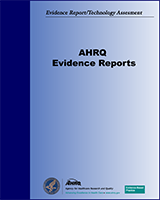NCBI Bookshelf. A service of the National Library of Medicine, National Institutes of Health.
Levine CB, Fahrbach KR, Siderowf AD, et al. Diagnosis and Treatment of Parkinson's Disease: A Systematic Review of the Literature. Rockville (MD): Agency for Healthcare Research and Quality (US); 2003 Jun. (Evidence Reports/Technology Assessments, No. 57.)
This publication is provided for historical reference only and the information may be out of date.

Diagnosis and Treatment of Parkinson's Disease: A Systematic Review of the Literature.
Show detailsObjective
The objective of this Task Order is to conduct a systematic review of the literature to assess the quantity and quality of available evidence regarding diagnosis and treatment of Parkinson's Disease (PD).
Project Status to Date
Thirteen key questions were posed by the Agency for Healthcare Research and Quality (AHRQ) and the American Academy of Neurology (AAN). After a preliminary review of the literature, MetaWorks and the Leonard Davis Institute (LDI) worked collaboratively to modify the original key questions, making them more amenable to answers by systematic literature review. The content of the revised questions is unchanged; however, they are now worded differently. In general, where the original questions asked about what kinds of testing or treatment “should” be done, or “what is the role” of a particular test or treatment, the modified questions ask “what are the results,” or “what is the evidence.”
Causal pathways relevant to the key objectives of this project were developed to help guide the literature review. Many of the elements included in the causal pathways are controversial, particularly the use of MAO-B inhibitors for neuroprotection, and the question of when L-Dopa should be started. One of the goals of this Task Order is to identify the weight of the available evidence regarding these and other issues.
After numerous discussions with representatives from AHRQ, AAN, and LDI, final decisions were made regarding the composition of the Technical Expert Panel (TEP) for this project. The TEP is composed of four neurologists/PD experts, one neurosurgeon/PD expert, one general neurologist, one general internist, and one PD patient, who is a cardiologist. This multidisciplinary approach will provide valuable feedback from a variety of perspectives.
The Work Plan and Causal Pathways were sent to all members of the TEP for review on September 19, 2000. Feedback was requested by October 16, 2000, and has been received from 7 of the 8 members of the TEP.
Based on preliminary assessment of the literature, relevant databases, input from collaborating partners, and feedback received from the TEP, the Work Plan and the Causal Pathways have been modified accordingly.
Twenty people have been invited to participate in the project as Peer Reviewers of our draft evidence report. To date, seven have accepted. More potential peer reviewers are being contacted, with an ultimate goal of at least twelve peer reviewers, from multiple disciplines.
To date, 957 abstracts have been identified from the Medline search, 397 from the Current Contents search, and 590 from the Cochrane Library search, yielding a total of 1,944 citations. After 614 duplicates were identified, a total of 1,330 abstracts were downloaded into Reference Manager at MetaWorks.
Level I screening of all abstracts for exclusion criteria has been completed, and resulted in 560 potential accepted studies. Full papers are being retrieved for all accepted abstracts.
Level 2 screening of the full articles for inclusion and exclusion criteria is nearly complete. All studies that are rejected at Level 2 are required to be reviewed by a second researcher, to insure that there is 100% consensus regarding which studies are to be rejected. Manual bibliography checks of all accepted studies are currently underway, in search of potential accepts that may not have been identified by electronic searches.
After Level 2 screening is complete, data extraction of the accepted articles will commence. The Revised Work Plan describes, in great detail, the remaining steps in the systematic review process. The draft Evidence Report will be submitted to AHRQ by July 2, 2001.
- Appendix C. Topic Assessment and Refinement - Diagnosis and Treatment of Parkins...Appendix C. Topic Assessment and Refinement - Diagnosis and Treatment of Parkinson's Disease
- Evidence Tables - Milk Thistle: Effects on Liver Disease and Cirrhosis and Clini...Evidence Tables - Milk Thistle: Effects on Liver Disease and Cirrhosis and Clinical Adverse Effects
- Appendix 4. Initial Abstraction Instrument - Rehabilitation for Traumatic Brain ...Appendix 4. Initial Abstraction Instrument - Rehabilitation for Traumatic Brain Injury
- Conclusions and Summary of Findings - Rehabilitation for Traumatic Brain InjuryConclusions and Summary of Findings - Rehabilitation for Traumatic Brain Injury
- RecName: Full=Choline O-acetyltransferase; Short=CHOACTase; Short=ChAT; Short=Ch...RecName: Full=Choline O-acetyltransferase; Short=CHOACTase; Short=ChAT; Short=Choline acetylasegi|416804|sp|Q03059.2|CLAT_MOUSEProtein
Your browsing activity is empty.
Activity recording is turned off.
See more...